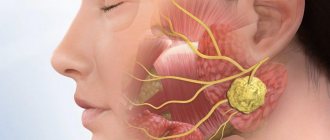Main characteristics
Lacunar tonsillitis is characterized by enlarged lymph nodes in the neck and damage to other organs responsible for breathing. Sore throat is an acute bacterial disease that is accompanied by swelling and redness of the larynx. Symptoms of lacunar tonsillitis in adults are similar to the pathology in children.
The soft tissues in the tonsil area swell and acquire a red tint, which is accompanied by inflammation of the palatine arch in the process of hyperemia. A white purulent plaque is localized in the area of the tonsils. By starting treatment immediately after the onset of ailments, the disease can be cured within 2 weeks.
Before starting treatment, the patient is examined by a doctor, takes the necessary tests and, based on them, makes a diagnosis, and then prescribes therapy.
Symptoms of lacunar tonsillitis
Diagnosis of lacunar tonsillitis is carried out only under the supervision of specialists. Trying to determine the disease on your own is not recommended. Symptoms of the disease are similar to those of other upper respiratory tract diseases.
Signs and symptoms of lacunar tonsillitis in children and adults:
- Pain in the throat (the patient at the beginning of the disease cannot swallow or even eat and drink. The pain in the throat radiates to the head. Children suffer from sore throat more severely than adults).
- An increase in body temperature to high values (with sore throat, the body temperature in some cases reaches up to 39 degrees, there are sudden changes in temperature).
- General weakness and malaise.
- Lack of appetite.
- Fever.
- Symptoms include plaque on the tonsils.
- Muscle pain and joint tenderness.
- Indigestion (vomiting or diarrhea).
- The surface of the tonsils becomes swollen and inflamed.
The incubation period for lacunar tonsillitis is 1–3 days. During this period, lacunar tonsillitis occurs without fever. After this, the signs of the onset of the disease clearly appear. First, the body temperature increases, and then there is a sore throat, swelling of the tonsils and redness of the throat. Lacunar tonsillitis is characterized by the appearance of a large number of pustules in the tonsil area.
In terms of symptoms, lacunar tonsillitis is similar to follicular tonsillitis, only the signs of pathology in the first case are more pronounced. In the case of follicular sore throat, body temperature does not rise above 38 degrees and urination becomes profuse. In rare cases, the pathology occurs without an increase in body temperature or remains around 37 degrees.
In children, symptoms are more severe than in adults. Against the background of fever, convulsions and loss of consciousness appear. In especially severe cases, irritation of the membranes of the brain occurs. Children with tonsillitis are characterized by vomiting, diarrhea, digestive problems, nasal voice and changes in timbre.
Symptoms and photos
Lacunar tonsillitis is characterized by a short incubation period. In a child it lasts up to several hours, but in an adult it can last about two days. At this time there are no signs of illness.
Upon completion of the period of adaptation of the pathogenic microenvironment, the following symptoms appear in adults and children:
- “Coma in the throat” syndrome in the tonsil area, the larynx is constantly sore, the lymph nodes under the jaw swell,
- Sensations of constriction and pain, which intensifies when swallowing or feeling the outside of the throat,
- The temperature rises sharply to 39 degrees, manifestations of toxic poisoning of the body appear, the person shudders, feels sick, has a headache, and has no appetite.
- Aches muscles and joints,
- Heart rate increases
Rarely is it diagnosed that there is no increase in body temperature. This situation is possible when an adult with a strong internal protective function is infected; children, as a rule, always suffer from fever.
The main symptom of the disease is the presence of a nagging sore throat that prevents you from eating and drinking normally. Here is the appearance of the throat with lacunar sore throat in the photo:
Photo 1. Stages of development
Photos 2, 3. What plaque looks like
Photo 4. Signs of white plaque
The color of the resulting plaque is yellowish-white. This is a purulent substance that accumulates in lacunae. With an abundance of purulent discharge, the lacunae merge, completely covering the tonsils. Removal of pus is possible using a medical spatula.
In its debut, the disease is very bright with pronounced symptoms, but the older the patient, the faster they subside. In adults, the elevated temperature persists for up to three days, in children this period is longer – up to a week.
At the final stage, the surface epithelium of the tonsils begins to recede, having undergone a necrotic process . Often this process is quite intense, as a result, the release of lacunae is accelerated, and as a result, serious wounds are noticeable in the place of the detached tissue. But this is normal - during the regeneration process they will quickly become covered with a new surface layer.
Complications
If the symptoms are ignored and no treatment is carried out, then lacunar tonsillitis leads to serious consequences, even fraught with death, which happens if a child gets sick. Self-therapy at home also has a positive effect on the progression of the disease - the use of decoctions and tinctures where only strong antibiotics can help.
Failure to seek medical help in a timely manner leads to additional complications and consequences, for example, the development of:
- Sinusitis,
- Bronchitis,
- Otitis,
- Jade,
- Pneumonia,
- Rheumatism,
- Heart problems
Other complications include lung abscess, sepsis, and meningitis. To make sure that lacunar tonsillitis has been completely overcome, both adults and children are recommended to take a general blood and urine test twice, a couple of weeks apart. Such a diagnosis will help to notice undertreatment and underlying pathologies.
How does infection occur?
The development of an infectious disease in humans begins with the transmission of bacteria from a patient through airborne droplets or household contact. Most often this happens if a healthy person has used hygiene items or cutlery for someone with a sore throat. The disease especially often spreads between family members. Therefore, the patient must use separate dishes and towels during the treatment period.
See also
Is it possible to smoke if you have a sore throat or tonsillitis?
Read
The development of the primary form of lacunar tonsillitis is promoted by:
- Streptococci belonging to group A.
- Pneumococci.
- Some types of viruses.
- Meningococci.
- Pathogenic fungi.
- Haemophilus influenzae.
Other factors in the development of pathology include the following:
- Decreased immune system after infectious diseases or vitamin deficiency.
- Prolonged exposure to cold or draft.
- Transition of other forms of angina into lacunar.
Symptoms and treatment of lacunar tonsillitis depend on the stage of the disease.
Causes
Sore throat can be triggered by a number of pathogens, including:
- microbes (usually streptococcus, but staphylococcus can also lead to the development of this disease);
- fungi;
- viruses (in more rare cases), including the herpes virus.
In some cases, lacunar tonsillitis can be caused by more severe diseases: tuberculosis or scarlet fever, in which the infection spreads to the palate.
Reduced immunity, hypothermia, stress, and poor living conditions contribute to the development of the disease in the body. The disease itself is transmitted by airborne droplets, and the likelihood of its initiation increases for those who use public transport or work in large groups.
Lacunar tonsillitis
Drug treatment
At the first signs of malaise and sore throat, you should contact your doctor for treatment.
Treatment of lacunar tonsillitis in adults with antibiotics consists of a course of taking the drugs for no more than 7 days. If the patient’s well-being begins to improve earlier, the course of drinking is not stopped until the end.
Taking antibiotics has the following effects on the body:
- Helps destroy the pathogen.
- Eliminates the occurrence of side effects in diseases associated with angina.
In the first 3 days of taking antibiotics, their overall effect on the body is assessed. Therefore, during these days the patient should be examined by a doctor and, if necessary (if improvement does not occur), prescribe another medicine. Among the common antibiotics for the treatment of sore throat are:
- Cephalexin.
- Sumamed.
- Ampicillin.
- Gramox.
Antibacterial treatment of lacunar tonsillitis in children is similar to antibiotic therapy in adults. The use of antibiotics for therapy often leads to digestive disorders. Therefore, along with the main treatment, a course of prebiotics is prescribed. For example, Lactobacterin, Polysorb, Linex.
One of the main drugs used to treat lacunar tonsillitis are solutions for rinsing the larynx. Hexoral has a beneficial effect. It helps to destroy microbes on the laryngeal mucosa, disrupting the metabolism in them. As an alternative, Stopangin is used, which coats the throat and relieves inflammation. Preparations for irrigating the throat are available in the form of sprays.
Local treatment includes a group of drugs for resorption. These lollipops contain a mild pain reliever, which helps relieve sore throats. Strepsils, Hexoral, Faringosept, Lizobakt are used for resorption.
To lubricate inflamed lacunae, doctors prescribe Lugol. This drug is used to lubricate a sore throat, regardless of the severity and condition of the patient. The procedure is repeated 3 to 6 times a day. A cotton swab is moistened with gel and the area of the gaps is lubricated. Then the pharynx and larynx are treated with the same stick.
If the body temperature is kept up to 38 degrees, it is not brought down. At this time, the body tries to independently fight pathogenic microflora. If the thermometer rises above 38, you need to start taking antipyretics. For example, Ibuprofen, Paracetamol, Metamizole sodium, Nurofen.
Therapy for lacunar tonsillitis is not complete without a course of antiviral medications (Kagocel, Remantadine, Cycloferon). Take antiviral medications if the sore throat was caused by viruses. Often, when viruses enter the body, nasal congestion occurs.
Causes
To develop the correct treatment, lacunar tonsillitis is divided into acute and chronic. Based on the existing symptoms, an appropriate diagnosis is made. The acute form is formed during primary infection of the tissue structure of the tonsils, the chronic form appears during exacerbations of tonsillitis of the same name.
Adults and children become infected with lacunar tonsillitis, the main reasons for this are:
- Introducing a large volume of infectious microenvironment,
- A state of decreased immune system strength,
- Weak protection at the local mucosal level,
You can get sick after one contact with an infected person, so in children's groups the disease spreads instantly. If one of the children has the slightest symptoms, he must be isolated and treated separately.
The causative agents of the primary form in adults and children are:
- Streptococcal, pneumococcal and staphylococcal infections,
- Fungal microorganisms
- Sticks,
- Different types of viruses
Lacunar tonsillitis penetrates into the throat tissue more easily if:
- The oropharynx or nasopharynx is inflamed,
- The teeth are unhealthy, there are pockets of caries and periodontal disease,
- The person was exposed to hypothermia,
- There is constant fatigue, which often happens with adults,
- You have to live in an environment with unfavorable ecology,
When treating lacunar tonsillitis, it is important to adhere to all recommendations and observe bed rest, otherwise the disease will drag on longer than the usual 1-1.5 weeks required for complete cure and recovery.
Traditional treatment of lacunar tonsillitis
You can resort to traditional methods of treating sore throat only with the permission of your doctor. Not all alternative medicine recipes are safe. Therefore, in order to prevent the development of complications, you need to be very careful. Lacunar tonsillitis should be treated immediately after consulting a doctor.
Effective recipes for relieving sore throat symptoms:
- Gargle the throat with warm milk mixed with mineral water. Hot milk is a product that additionally has an enveloping effect.
- It is recommended to gargle a sore throat with baking soda. Baking soda has a disinfecting effect and helps wash away germs from the mucous membrane. Dissolve 1 tbsp in 200 ml of warm water. l. soda Add a few drops of iodine, stir thoroughly and start gargling. The procedure should be carried out after meals and for several hours afterward, do not eat or drink. You need to gargle every 2 hours.
- Onion and garlic juice helps destroy germs. Grate the onion and garlic on a fine grater, squeeze out the juice and mix with 100 g of linden honey. Mix the medicine and take 1 tsp. each hour.
- A decoction of oak bark relieves inflammation from lacunae. Pour 40 g of crushed dry oak bark into 450 ml of boiling water. Cook over medium heat for 30 minutes. Then remove from the stove and let the broth brew for 2 hours.
- Vegetable juice helps relieve inflammation in the throat. You should only use freshly squeezed carrot, cabbage or beet juice. Add 10-20 drops of lemon juice to the juice and rinse the sore throat.
See also
Carrying out surgery to remove tonsils for chronic tonsillitis and rehabilitation after
Read
Gargle the throat with decoctions of medicinal herbs and table salt. These products are no less effective than drugs from the pharmacy. With special care, the larynx is rinsed with decoctions of medicinal herbs. Before the procedure, you need to make sure that the patient is not allergic to them and only then proceed.
Causes of the disease
Decreased immunity is always the root cause of all infectious diseases, but even a healthy immune system may not cope with bacterial attacks in some cases:
- Contact with carriers of infection, where focal accumulations of bacteria are significantly higher than the quantitative norm that makes up the body’s natural microflora.
- Natural factors that increase the load on the immune system. These are sudden changes in atmospheric pressure and air temperature, climate change.
- Immaturity of the body in childhood.
- Hormonal age-related changes.
Provoking factors, risk group
The prerequisites for the development of angina are:
- Viral infections.
- Hypothermia.
- Untreated foci of infection (pharyngitis, caries, otitis media, rhinitis).
- Stressful situations.
- Unbalanced diet.
- Polluted, dusty air.
- Avitaminosis (lack of vitamins).
- Bad habits.
- The period after a protracted illness.
- Pathologies of the immune system.
- Violation of personal hygiene.
- Throat injuries.
- Allergies.
Children are statistically more susceptible to tonsillitis than adults. In old age, cases of this disease are extremely rare.
Infection with streptococci in the summer occurs less frequently than in the autumn-winter period, but is more acute due to the faster spread of bacteria in hot weather.
About the causes and symptoms of sore throat in our video:
Complications
Complications after lacunar tonsillitis occur if treatment was not prescribed on time. Or if the treatment was prescribed independently without going to the clinic. In case of a serious condition of the patient, an ambulance is urgently called to the house.
Among the complications after inflammation of the throat lacunae are:
- Sinusitis.
- Nephritis.
- Bronchitis.
- Otitis.
- Myocarditis.
- Rheumatism.
- Pneumonia.
- Other respiratory diseases.
Severe complications include abscesses, sepsis, phlegmon, and paratonsillitis. After illness, to exclude the development of complications, they return to the doctor. If necessary, blood and urine tests are taken, as well as an ECG. These measures will allow you to immediately find out whether there are complications after the disease and prevent them in time. Going to the hospital at the end of the illness is a mandatory measure.
Diagnostics
The standard diagnostic plan includes:
- taking anamnesis;
- initial examination;
- palpation of lymph nodes;
- clinical blood test;
- general urine analysis;
- blood biochemistry;
- throat swab and its further bacteriological examination. A diagnostic method that makes it possible to identify the pathogen;
- immunological research;
- ECG;
- pharyngoscopy;
- laryngoscopy.
Carrying out laryngoscopy
Prevention of lacunar tonsillitis
Preventing the symptoms of lacunar tonsillitis will help you avoid the development of this unpleasant disease and stay healthy. Lacunar tonsillitis is a contagious disease, so it is better to isolate the sick person, especially if there are small children in the house.
At an early age, they have not yet developed their own immune system and contact with a sick person leads to the development of the disease in the child.
Prevention is also important against the development of chronic inflammation of the throat. The following are identified as preventive measures:
- Hardening the body.
- Taking a contrast shower.
- Regular wet cleaning of the house.
- Proper nutrition, including more fresh vegetables and fruits in the diet.
- Taking a complex of vitamins and minerals during the cold season.
- Physical activity.
- Timely treatment of dental caries and gum disease.
- Walks in the open air.
The main thing to do as a preventive measure is to strengthen the immune system. At the first signs of illness, you need to visit a doctor and then the likelihood of curing the pathology quickly increases several times.
Differences between lacunar angina and the follicular form of the disease
Sore throat itself is considered an acute illness of an infectious nature, which can be caused by viruses, bacteria or fungi and occurs primarily in the tonsils. Another name for this disease, less known in everyday life, but more popular among doctors, is acute tonsillitis.
The initial stage of this pathological process is usually called catarrhal tonsillitis. However, in addition to it, in medical practice there is also a distinction between lacunar and follicular tonsillitis, the differences between which are that in the case of the follicular form of the disease, deeper damage to the tonsils occurs. In this case, the so-called follicles of the tonsils, which are the glandular component of these structures, are drawn into the pathogenic process. During the examination, festering follicles are visible through the mucous membrane in the form of small yellow-white bubbles.
Lacunar tonsillitis, a photo of which can be seen below, manifests itself somewhat differently.
But more on this in the corresponding section of the article. First, it’s worth talking about the causes of this disease.












